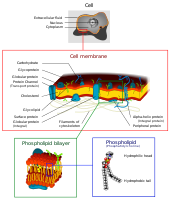
Intracellular transcytosis of albumin in glomerular endothelial cells after endocytosis through caveolae
Sign Up to like & getrecommendations! Published in 2017 at "Journal of Cellular Physiology"
DOI: 10.1002/jcp.25817
Abstract: We previously described albumin endocytosis through caveolae in human renal glomerular endothelial cells (HRGECs). This suggested a new albumin transcytosis pathway, in addition to the fenestral pathway. As a next step, we investigated albumin transcytosis… read more here.
Keywords: caveolae; glomerular endothelial; endocytosis; endothelial cells ... See more keywords

A quantitative model for the caveolae under cell membrane stretch
Sign Up to like & getrecommendations! Published in 2020 at "Biomechanics and Modeling in Mechanobiology"
DOI: 10.1007/s10237-020-01362-z
Abstract: In this paper, we proposed a two-state model to quantitatively illustrate the working mechanism of caveolae structure in the regulation of cell membrane stretch. First, we derived the free energy compositions of one caveola in… read more here.
Keywords: caveolae; model; cell membrane; membrane stretch ... See more keywords

Caveolin and lipid domains–close companions in managing cellular pathways
Sign Up to like & getrecommendations! Published in 2020 at "Cancer and Metastasis Reviews"
DOI: 10.1007/s10555-020-09891-w
Abstract: Identification of lipid rafts (highly dynamic plasma membrane domains enriched in cholesterol and sphingolipids) and caveolae, a subdomain of lipid rafts, established a foundation for a remarkable period of multidisciplinary research on the molecular and… read more here.
Keywords: caveolae; caveolin; cav1; cancer ... See more keywords

Membrane tension buffering by caveolae: a role in cancer?
Sign Up to like & getrecommendations! Published in 2020 at "Cancer and Metastasis Reviews"
DOI: 10.1007/s10555-020-09899-2
Abstract: Caveolae are bulb-like invaginations made up of two essential structural proteins, caveolin-1 and cavins, which are abundantly present at the plasma membrane of vertebrate cells. Since their discovery more than 60 years ago, the function of… read more here.
Keywords: caveolae; membrane tension; caveolae role; role cancer ... See more keywords

Caveolae Protect Notochord Cells against Catastrophic Mechanical Failure during Development
Sign Up to like & getrecommendations! Published in 2017 at "Current Biology"
DOI: 10.1016/j.cub.2017.05.067
Abstract: The embryonic notochord is a flexible structure present during development that serves as scaffold for formation of the vertebrate spine. This rod-like organ is thought to have evolved in non-vertebrate chordates to facilitate locomotion by… read more here.
Keywords: caveolae; mechanical stress; caveolae protect; notochord ... See more keywords

Coupling of melanocyte signaling and mechanics by caveolae is required for human skin pigmentation
Sign Up to like & getrecommendations! Published in 2020 at "Nature Communications"
DOI: 10.1038/s41467-020-16738-z
Abstract: Tissue homeostasis requires regulation of cell–cell communication, which relies on signaling molecules and cell contacts. In skin epidermis, keratinocytes secrete factors transduced by melanocytes into signaling cues promoting their pigmentation and dendrite outgrowth, while melanocytes… read more here.
Keywords: caveolae; coupling melanocyte; skin pigmentation; pigmentation ... See more keywords

Mechanics of cup-shaped caveolae.
Sign Up to like & getrecommendations! Published in 2021 at "Physical review. E"
DOI: 10.1103/physreve.104.l022401
Abstract: Caveolae are cell membrane invaginations of defined lipid and protein composition that flatten with increasing membrane tension. Super-resolution light microscopy and electron microscopy have revealed that caveolae can take a variety of cuplike shapes. We… read more here.
Keywords: microscopy; caveolae; membrane; membrane tension ... See more keywords

Caveolae promote successful abscission by controlling intercellular bridge tension during cytokinesis
Sign Up to like & getrecommendations! Published in 2022 at "Science Advances"
DOI: 10.1126/sciadv.abm5095
Abstract: During cytokinesis, the intercellular bridge (ICB) connecting the daughter cells experiences pulling forces, which delay abscission by preventing the assembly of the ESCRT scission machinery. Abscission is thus triggered by tension release, but how ICB… read more here.
Keywords: intercellular bridge; abscission; cytokinesis; tension ... See more keywords

212 Suppressor of cytokine signalling 3 (socs3) interaction with cavin-1 links socs3 function and cavin-1 stability
Sign Up to like & getrecommendations! Published in 2017 at "Heart"
DOI: 10.1136/heartjnl-2017-311726.210
Abstract: Caveolae are lipid raft microdomains essential for the compartmentalisation and regulation of several signalling pathways e.g. JAK/STAT signalling. Disruption of caveolae is a significant factor in multiple disorders including muscular dystrophy, cardiovascular disease, and cancer.… read more here.
Keywords: caveolae; socs3; jak stat; cavin ... See more keywords

Caveolin-1 Regulates Atherogenesis by Attenuating LDL Transcytosis and Vascular Inflammation Independent of Endothelial Nitric Oxide Synthase Activation.
Sign Up to like & getrecommendations! Published in 2019 at "Circulation"
DOI: 10.1161/circulationaha.118.038571
Abstract: BACKGROUND Atherosclerosis is driven by synergistic interactions between pathological biomechanical, inflammatory and lipid metabolic factors. Our previous studies demonstrated that absence of caveolin-1 (Cav1)/caveolae in hyperlipidemic mice strongly inhibits atherosclerosis, which was attributed to activation… read more here.
Keywords: caveolae; atherosclerosis; nitric oxide; cav1 caveolae ... See more keywords

A Role of Caveolae in Trabecular Meshwork Mechanosensing and Contractile Tone
Sign Up to like & getrecommendations! Published in 2022 at "Frontiers in Cell and Developmental Biology"
DOI: 10.3389/fcell.2022.855097
Abstract: Polymorphisms in the CAV1/2 gene loci impart increased risk for primary open-angle glaucoma (POAG). CAV1 encodes caveolin-1 (Cav1), which is required for biosynthesis of plasma membrane invaginations called caveolae. Cav1 knockout mice exhibit elevated intraocular… read more here.
Keywords: contractile tone; cav1; trabecular meshwork; caveolae ... See more keywords